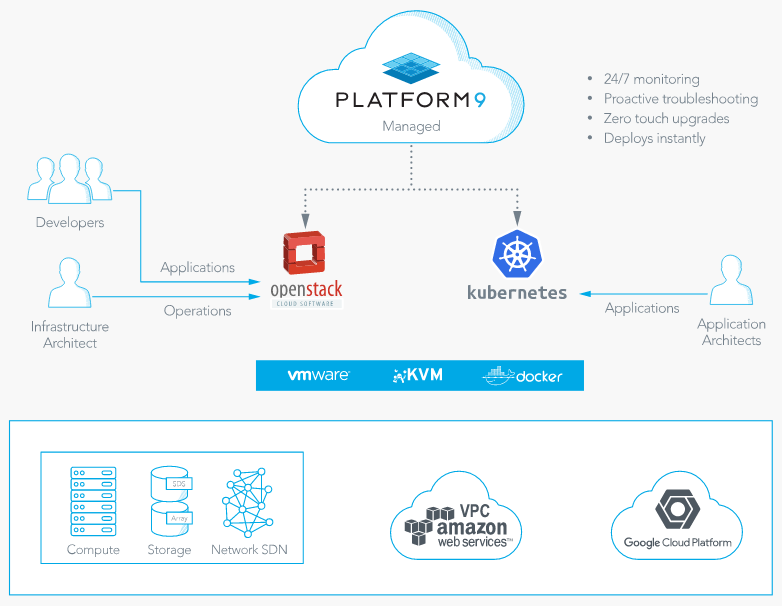Platform9 is a company founded by VMware engineers (with several years of experience) who have taken a fundamentally new approach to creating and managing private clouds. Their management SaaS solution (or MaaS) went GA two years ago and as grow really faster and moving from the managing of on-prem resources (KVM and vSphere environments) with the all stack (including storage and networking) to public clouds and containers.
Platform9’s model makes it easy to run hybrid clouds across any infrastructure, using leading Open Source cloud frameworks based on OpenStack for VM and IaaS management and Kubernetes for Container Orchestration.
Platform9’s SaaS platform lets you go live with your OpenStack private cloud within few minutes (and just 5 simple steps) using our deployment tools and can manage:
- VMs (vSphere and KVM) with the entire stack (including compute and storage)
- Public cloud (actually AWS and Google)
- Bare metal
- Containers
Easy setup is only half the story. Platform9 support takes care of the entire OpenStack lifecycle (including 24/7 health monitoring, alerting, troubleshooting and upgrades)!
The private cloud management it’s almost complete but also quite traditional: you can easily manage both KVM and VMware vSphere resources within a single private cloud platform, giving you a true single pane of glass across mixed environments while reducing IT management overhead. Each physical domain of locally-networked servers running a supported common hypervisor platform it’s just organized as a “OpenStack region”. Actually Hyper-V support is missing, but on the other side several functions are added to the standard management, like VM HA also for KVM environment (see this post for more information) or automation functions like autoscaling. And, of course, due to the standard OpenStack API more automation is possible.
More interesting, in my point of view, is the Kubernetes delivered as a Service for containers and cloud native applications. Also in this case a set of enterprise functions are provided, like the high availability design: managed Kubernetes creates multi-master, multi-etcd Kubernetes clusters that can span across availability zones in your private or public cloud environment. This means your Kubernetes environment can tolerate local failures across one or more availability zones.
In this way you can just focus on the application design and develop cycle, instead of build and manage the infrastructure and related services.
“Managed Kubernetes provides significant value to companies that are serious about use of containers because it eliminates the complexity of managing the container orchestration layer, while running on any infrastructure” – Kuldeep Chowhan, Cloud Architect at Expedia
If you want to try all the core features of OpenStack and Kubernetes and see how easy it is to deploy, manage and scale a cloud infrastructure, you use the Sandbox experience available for 24 hours.
For more information see also:
- Platform9 Presents at Tech Field Day 13
- Platform9 can now manage Docker containers
- Platform9 adds networking and storage management
- Platform9 launch a Cloud Managed Platform
- Platform9 provide VMware vSphere SaaS management
Disclaimer: I’ve been invited to #TFD13 event by Gestalt IT and they will paid for accommodation and travels, but I’m not compensated for my time and I’m not obliged to blog. Furthermore, the content is not reviewed, approved or published by any other person than me.




